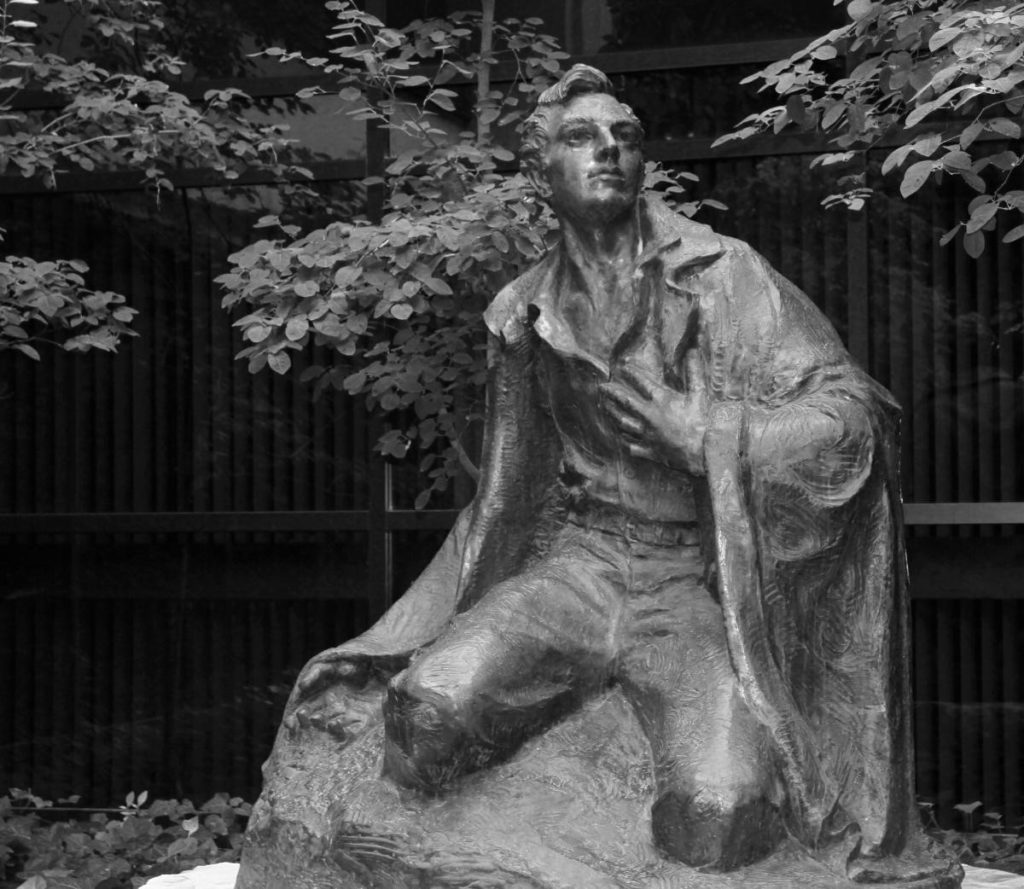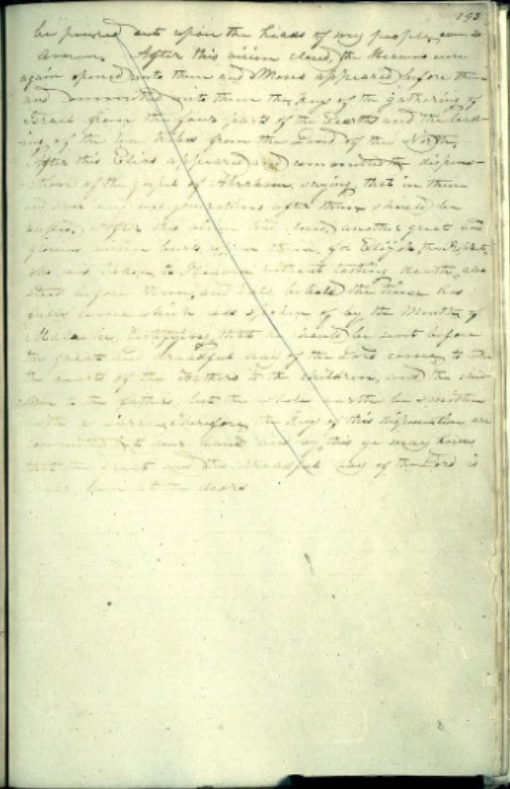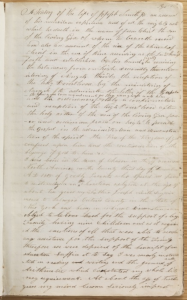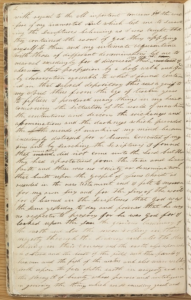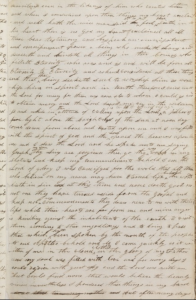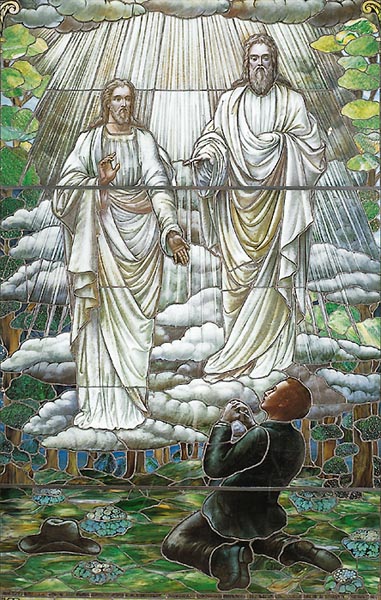Section 6
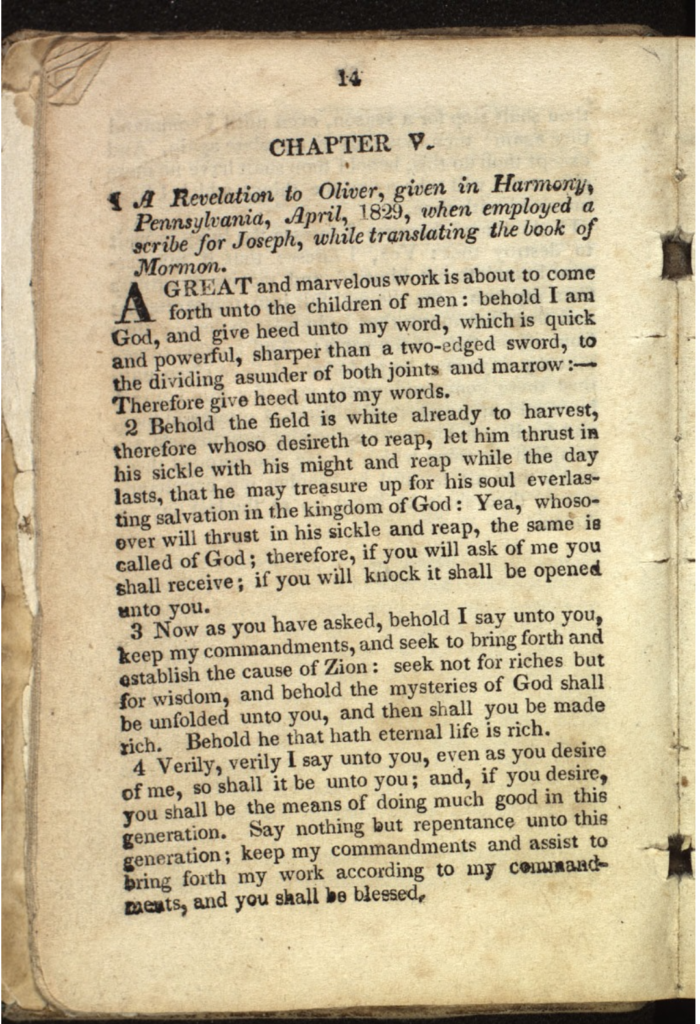
Early in 1829, Joseph’s father-in-law was about to evict him. Joseph “cried unto the Lord that he would provide for me to accomplish the work whereunto he had commanded me.”[1] This prayer was answered on a Sabbath evening when Joseph’s younger brother Samuel arrived with a twenty-two-year-old school teacher named Oliver Cowdery.
Oliver had learned about the marvelous work from Joseph’s family. He had prayed to know the truth of the matter and the Lord showed him the Book of Mormon plates in a vision, and told him of the translation Joseph had begun.[2] Oliver probably brought with him some money for Joseph to use to make a payment to his father-in-law.
On the second day after his arrival, Oliver began scribing as Joseph translated the Book of Mormon. Oliver had a normal inclination to fear and doubt things that had been revealed to him before. He wanted to know if he could believe what he was seeing and experiencing. The Lord responded with the reassuring revelation in section 6.
Speaking through Joseph but to Oliver, the Lord assures him that his gifts are indeed divine, and that the revelation he received before was too. This has the effect of convincing Oliver once and for all that Joseph, however unrefined or lacking in literacy, is the Lord’s chosen seer, for out of Joseph’s mouth came words of Jesus Christ, telling Oliver things Jesus knew but Joseph didn’t. Oliver wrote to David Whitmer saying that Joseph had “told him secrets of his life that he knew could not be known to any person by himself, in any way other than by revelation from the Almighty.”[3]
Section 6 foreshadows sections 7 and 8 by telling Oliver about records that have been kept hidden due to wickedness and that Oliver can have the gift to translate if he desires it. The revelation foreshadows martyrdom, but it is encouraging and empowering to Oliver.
It also bears a beautiful autobiographical witness of Christ, perhaps even in a visual way for Joseph and Oliver, the two young seers. The Lord invites them to “look unto me in every thought; doubt not, fear not. Behold the wounds which pierced my side, and also the prints of the nails in my hands and feet” (36-37). Like Peter, beholding the risen Christ gives Joseph and Oliver apostolic courage.
What we have in Section 6, then, is a document of the Lord’s lovingly employed omniscience. He is not the arbitrary sovereign Oliver’s ancestors imagined him to be.[4] He uses his limitless power to address the needs of those who desire and ask. He proves to Oliver that Joseph Smith, whatever his “faults” (v. 19), is the Lord’s chosen seer. The revelation not only says those things. By its delivery through Joseph and its secrets known only to the Lord and Oliver, it illustrates them.
Section 7
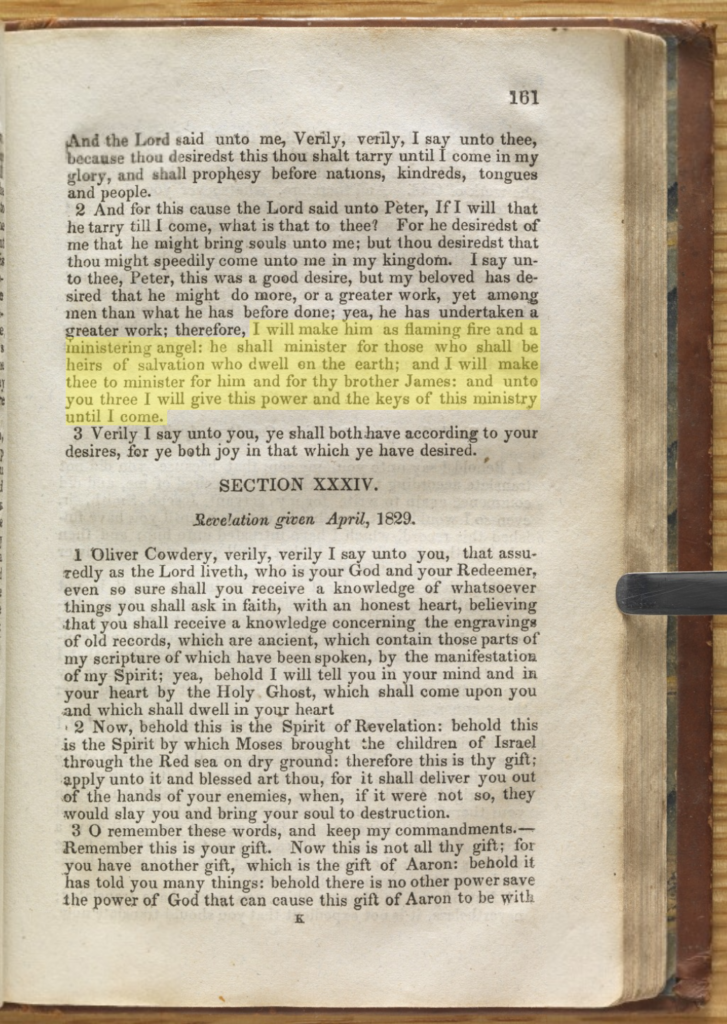
In the spring of 1829, as they translated and scribed the Book of Mormon, nothing excited the young seers Joseph and Oliver more than the idea of sacred ancient writings that had not yet come to light. The Book of Mormon was not just the best example of this, it mentioned many other texts. The Lord told Oliver in section 6 that he could, like Joseph, translate records like these if he desired.[1]
As they translated, they discussed John chapter 21:20-23. What did the words mean: “that disciple should not die”? Was John still alive? The text itself is ambiguous. Bible scholars had been “puzzled with this passage,” and Joseph and Oliver couldn’t agree on its meaning.[2] They agreed to seek clarifying revelation through the seer stones Joseph used to interpret the Book of Mormon. There they saw a parchment John had written and hidden.[3]
The parchment is apparently the original source for John’s Gospel in the New Testament. The revelation of the parchment to Joseph and Oliver restores much that was lost from the final few verses of John 21. The Lord did give John power. As the revelation was first recorded, this was power to bring souls to Christ. When Joseph reviewed the revelations for publication in 1835, he clarified that John asked the Lord for “power over death, that I may live and bring souls to thee.”[4] The Lord granted John’s desire.
Joseph also added to the 1835 Doctrine and Covenants the words in verse 6-7. The Lord said of John, “I will make him as flaming fire and a ministering angel: he shall minister for those who shall be heirs of salvation who dwell on the earth.” The Lord said to Peter, “and I will make thee to minister for him and for thy brother James: and unto you three I will give this power and the keys of this ministry until I come.”[5]
This section clarifies an ambiguous Bible passage and satisfied Joseph and Oliver’s curiosity. It does more work than that, however. It restores to the scriptures the fact that Jesus gave keys of salvation to Peter, James, and John. The revelation confirms that the Bible is true even as it confirms that the Bible is not complete. Nor is the Bible sufficient for salvation. We don’t just have the incomplete records of dead apostles. Jesus Christ sent Peter, James, and John back to earth to confer their keys on Joseph Smith and Oliver Cowdery, not too long after they received this revelation.
Many years later, the apostle Boyd K. Packer stood with President Spencer W. Kimball, other apostles, and local church leaders in the Church of Our Lady in Copenhagen, Denmark, admiring Bertel Thorvaldsen’s Christus and his sculptures of the twelve apostles. The sculpture of Peter holds symbolic keys in his hand, given him by Jesus Christ. President Kimball pointed them out and then then charged the Copenhagen stake president to “tell every prelate in Denmark that they do not hold the keys. I hold the keys!” As the party left the church, President Kimball shook hands with the caretaker, “expressed his appreciation, and explained earnestly, ‘These statues are of dead apostles,’” then said, “you are in the presence of living apostles.”[6]
Section 8
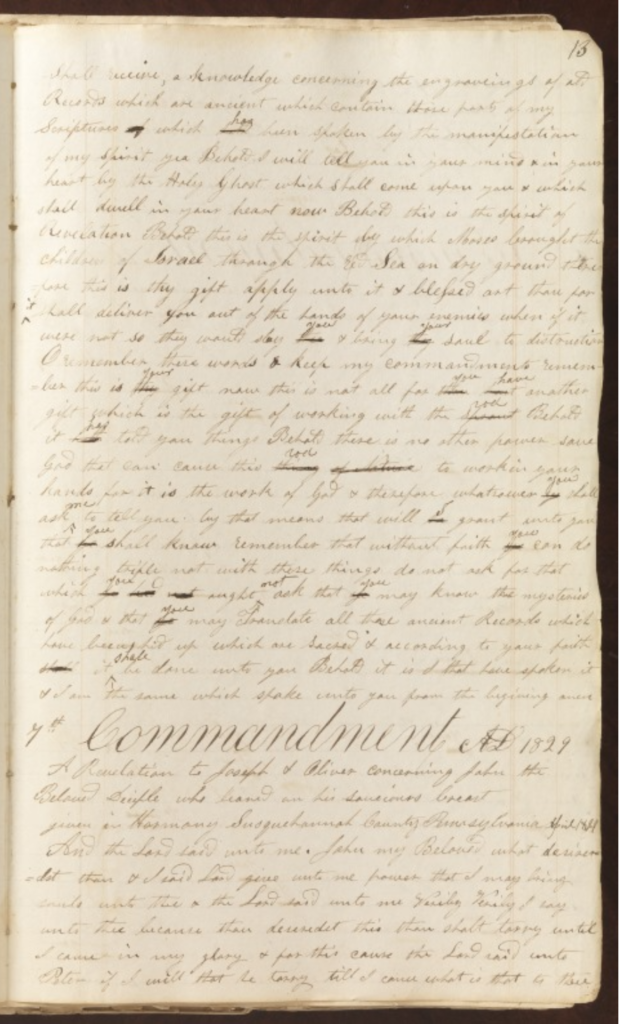
The Lord told Oliver he could translate ancient records in section 6, then showed him an ancient record in section 7. Joseph said Oliver “became exceedingly anxious to have the power to translate bestowed upon him,” so Joseph asked the Lord and received section 8.[1]
In the revelation the Lord tells Oliver the conditions on which he’ll be able to translate. He’ll have to seek the necessary knowledge honestly, in faith, believing in the Lord’s promise. The Lord, in turn, will tell Oliver this knowledge in his heart by the power of the Holy Ghost. This spirit of revelation guided Moses in leading the children of Israel safely through the Red Sea. It is now Oliver’s gift. “Apply unto it,” the Lord commands him.
The Lord also reminds Oliver of his other gift: The gift possessed by Moses’ brother Aaron–the gift of working with a divining rod, or, as the earliest extant manuscript of this revelation puts it, “the gift of working with the sprout.”[2] It has already told Oliver many things, and may be what the Lord alludes to in D&C 6:11-12. The Lord affirms and validates this gift and commands Oliver not to trifle with the gift or ask for things that he ought not.
So what should he ask for? He should ask to know the mysteries of God. He should ask to translate and receive knowledge from ancient records that have been kept hidden. The Lord will grant these desires according to Oliver’s faith, just as he has done all along.
Means of receiving revelation including Oliver’s rod, Lehi’s “miraculous directors,” Joseph’s seer stones, or the Brother of Jared’s were apparently more common anciently and in Joseph’s day than in ours (D&C 17:1). By 1829 when this revelation was given, such gifts were being questioned. Skepticism of “means,” as the scriptures call these objects, were beginning to be explained in naturalistic terms instead.[3]
Before publishing this revelation in the 1835 Doctrine and Covenants, Joseph took out the explicit mention of Oliver’s rod and referred to it vaguely to “the gift of Aaron” (D&C 8:6). This revelation neither denies nor discourages either of Oliver’s gifts, however. As commanded, Oliver did not trifle with his rod or make it known to unbelievers (D&C 6:11). Little is known about it in our time, when natural rather than supernatural explanations are preferred. Perhaps the equally marvelous, supernal gift of the Holy Ghost remains nearly as mysterious. It is widely available, yet few “apply unto it” as the revelation commands (D&C 8:4).
Section 9
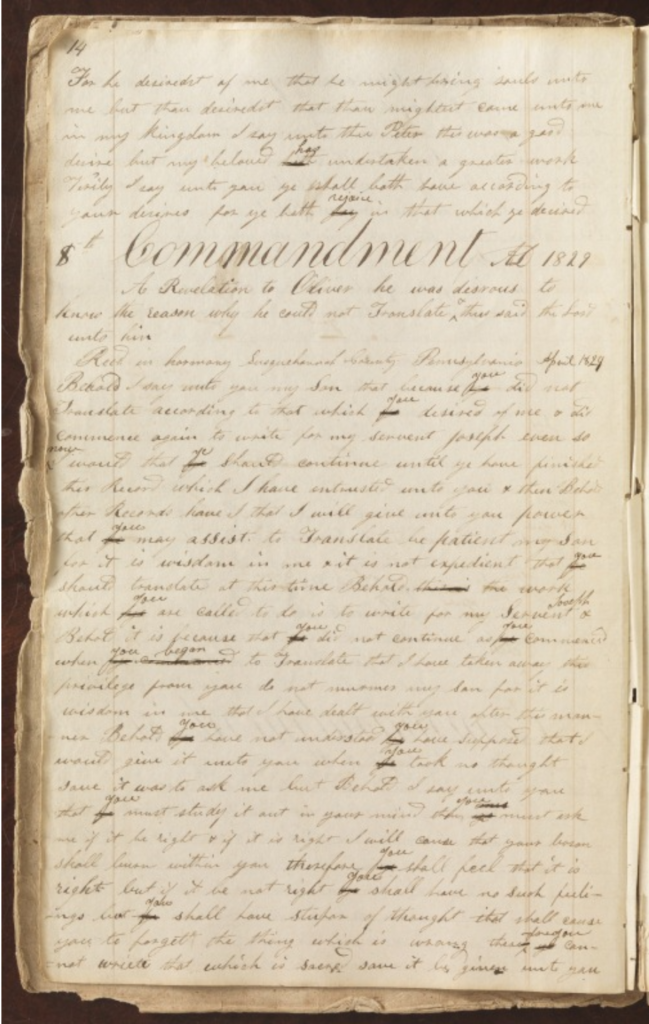
Oliver couldn’t translate. Why, after the Lord had said he could? He wanted to know, and the Lord told him in section 9.[1] Oliver did not understand what it took to translate by the gift and power of God, and the only way he was going to gain understanding was to try it. He made a start but could not continue.
His efforts were undermined by his assumption that all he had to do was ask and the Lord would do the rest. Not so, the Lord explained. Oliver learned a lesson about revelation that is best understood through experience. Revelation is an active, not passive process, requiring a combination of spiritual sensitivity and intellectual exertion.
Before Oliver arrived on the scene, Joseph had also struggled to learn the process of revelation. Joseph worked hard to translate, to apply the gift and power of God. As a result of Oliver’s failure to translate and the Lord’s explanation, Oliver gained respect for Joseph’s gift he would never lose and knowledge about the process of revelation he would never forget.[2]
The process of revelation is usually learned after wrestling with it for a while, gaining experience with how it feels in both the heart and the mind, and then applying it, as the Lord told Oliver to do in section 8. This revealed recipe for receiving revelation is a lot more than the common refrain, “just pray about it.” Revelation seldom comes so cheaply.
The Lord promised Oliver other opportunities to translate later, but for now he was to finish what he had started, scribing the Book of Mormon. Oliver was faithful to that charge, as the manuscripts in his handwriting attest.[3] Years later he testified, “That book is true. Sidney Rigdon did not write it. Mr Spaulding did not write it. I wrote it myself as it fell from the lips of the prophet.”[4]
Section 6 notes
[1] “History, circa Summer 1832,” p. [6], The Joseph Smith Papers, accessed July 22, 2020, https://www.josephsmithpapers.org/paper-summary/history-circa-summer-1832/6 .
[2] “History, circa Summer 1832,” p. [6], The Joseph Smith Papers, accessed July 22, 2020, https://www.josephsmithpapers.org/paper-summary/history-circa-summer-1832/6 . “History, 1838–1856, volume A-1 [23 December 1805–30 August 1834],” p. 15, The Joseph Smith Papers, accessed July 22, 2020, https://www.josephsmithpapers.org/paper-summary/history-1838-1856-volume-a-1-23-december-1805-30-august-1834/21.
[3] James H. Hart, “About the Book of Mormon,” Deseret News (Salt Lake City), 9 Apr. 1884, 190; see also “Report of Elders Orson Pratt and Joseph F. Smith,” Deseret News, 27 Nov. 1878, 674.
[4] In his famous 1741 sermon, “Sinners in the Hands of an Angry God,” Jonathan Edwards described “the mere pleasure of God, I mean his sovereign pleasure, his arbitrary will, restrained by no obligation.” John E. Smith, Harry S. Stout, and Kenneth P. Minkema, editors, A Jonathan Edwards Reader (New Haven: Yale University Press, 1995), 90.
Section 7 notes
[1] “Revelation, April 1829–A [D&C 6],” The Joseph Smith Papers, accessed July 22, 2020, https://www.josephsmithpapers.org/paper-summary/revelation-april-1829-a-dc-6/1.
[2] Adam Clarke, The New Testament of Our Lord and Saviour Jesus Christ. The Text Carefully Printed from the Most Correct Copies of the Present Authorised Version, Including the Marginal Readings and Parallel Texts. . . . Vol. 1 (New York: J. Emory and B. Waugh, 1831), 631.
[3] “Account of John, April 1829–C [D&C 7],” The Joseph Smith Papers, accessed July 22, 2020, https://www.josephsmithpapers.org/paper-summary/account-of-john-april-1829-c-dc-7/1.
[4] 1835 Doctrine & Covenants 33:1 (D&C 7:2).
[5] “Doctrine and Covenants, 1835,” p. 161, The Joseph Smith Papers, accessed July 22, 2020, https://www.josephsmithpapers.org/paper-summary/doctrine-and-covenants-1835/169.
[6] Boyd K. Packer, The Holy Temple (1980), 83. Edward L. Kimball, Lengthen Your Stride: The Presidency of Spencer W. Kimball (Salt Lake City: Deseret, 2005), 108, 327.
Section 8 notes
[1] “History, 1838–1856, volume A-1 [23 December 1805–30 August 1834],” p. 16, The Joseph Smith Papers, accessed July 22, 2020, https://www.josephsmithpapers.org/paper-summary/history-1838-1856-volume-a-1-23-december-1805-30-august-1834/22.
[2] “Revelation, April 1829–B [D&C 8],” p. 13, The Joseph Smith Papers, accessed July 22, 2020, https://www.josephsmithpapers.org/paper-summary/revelation-april-1829-b-dc-8/2. Richard L. Bushman, Joseph Smith: Rough Stone Rolling (New York: Knopf, 2005), 73. Robert J. Woodford, “Historical Development of the Doctrine and Covenants,” (Brigham Young University, PhD dissertation, 1974): 185-89.
[3] See all of Alma 37. Also 1 Nephi 16:29, Mosiah 8:15-18, D&C 10:1, JS-H 1:62.
Section 9 notes
[1] “Revelation Book 1,” p. 14, The Joseph Smith Papers, accessed July 22, 2020, https://www.josephsmithpapers.org/paper-summary/revelation-book-1/8.
[2] Oliver Cowdery, Norton, OH, to William W. Phelps, 7 Sept. 1834, LDS Messenger and Advocate, Oct. 1834, 1:14.
[3] Printer’s Manuscript of the Book of Mormon, circa August 1829-circa January 1830, https://www.josephsmithpapers.org/paper-summary/printers-manuscript-of-the-book-of-mormon-circa-august-1829-circa-january-1830/1. Book of Mormon Original Manuscript (1829) https://history.churchofjesuschrist.org/content/library/book-of-mormon-original-manuscript-1829?lang=eng.
[4] See Reuben Miller’s journal, 1848-1849, Church History Library, MS 1392, https://catalog.churchofjesuschrist.org/record?id=0448e354-d892-4ea7-9e2a-28b714114909&compId=22222322-f4fe-41e3-aa86-bfc54b94df92&view=browse.

